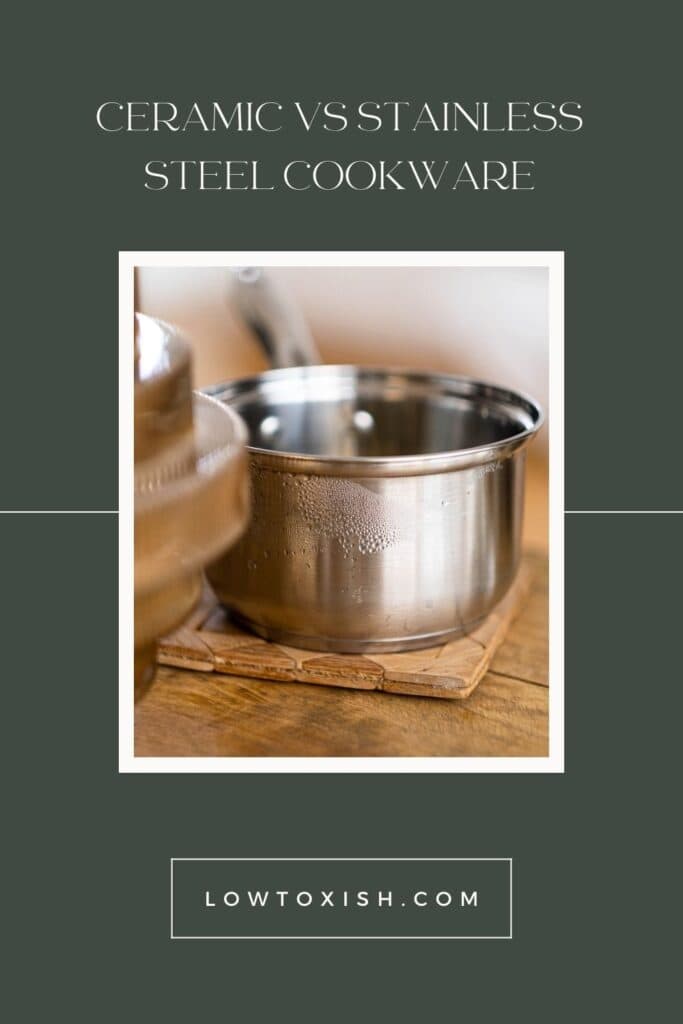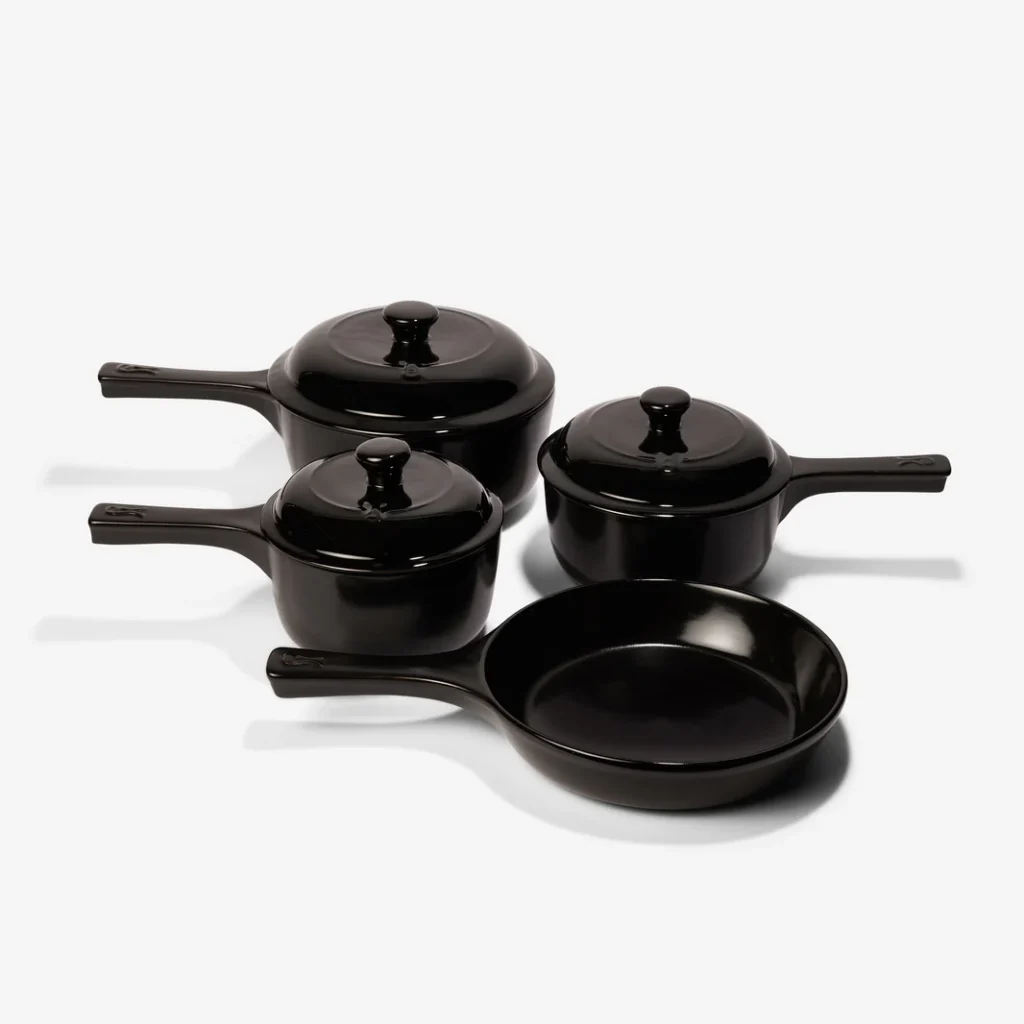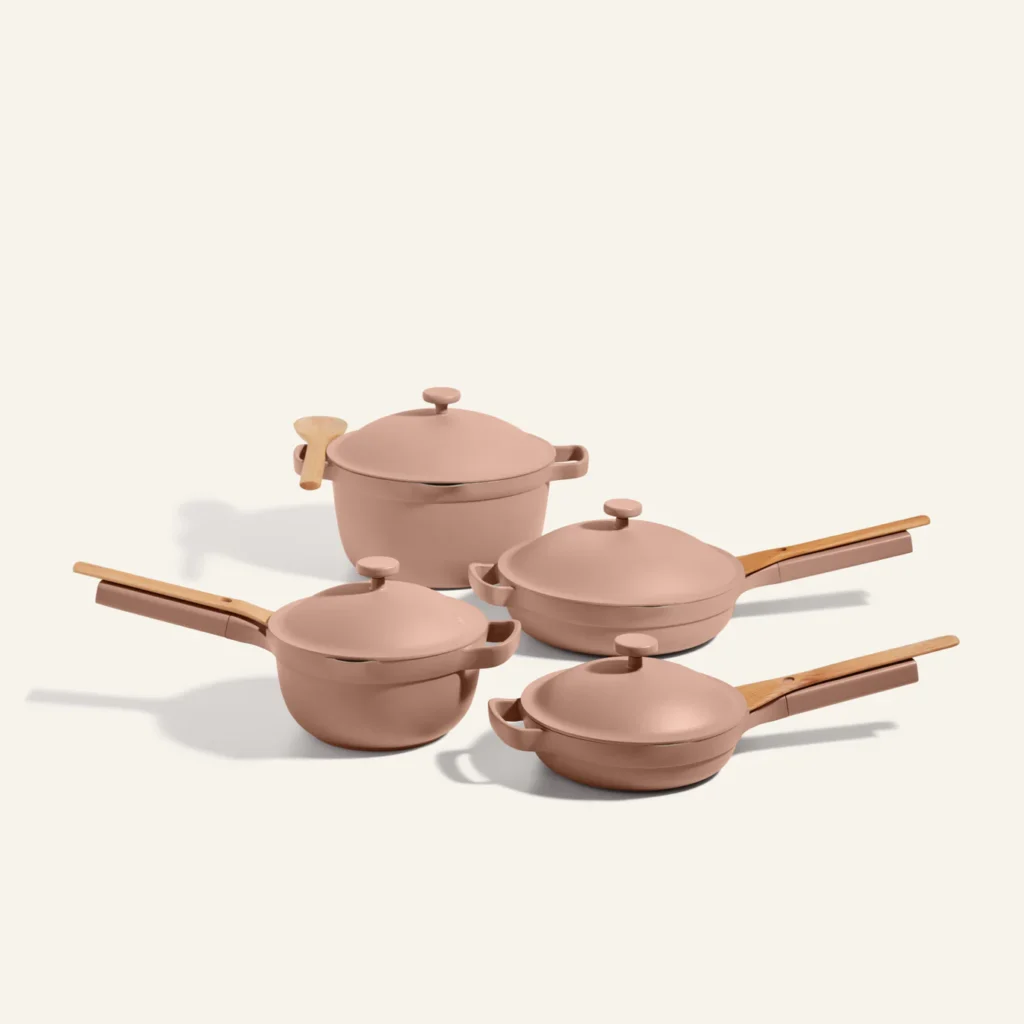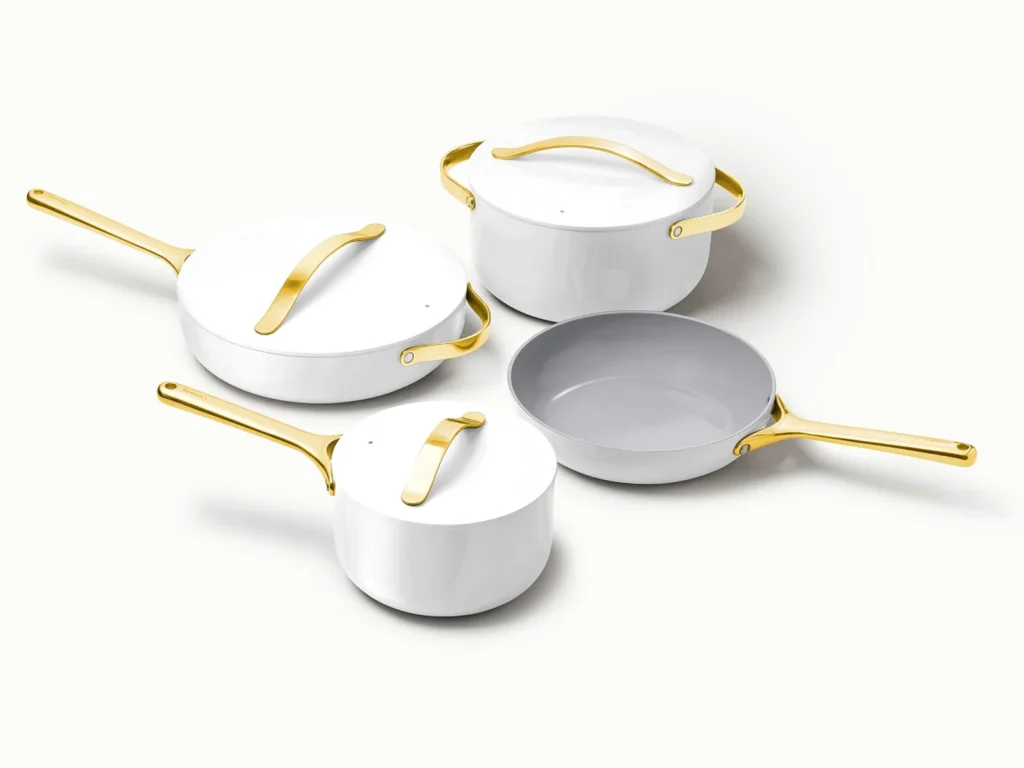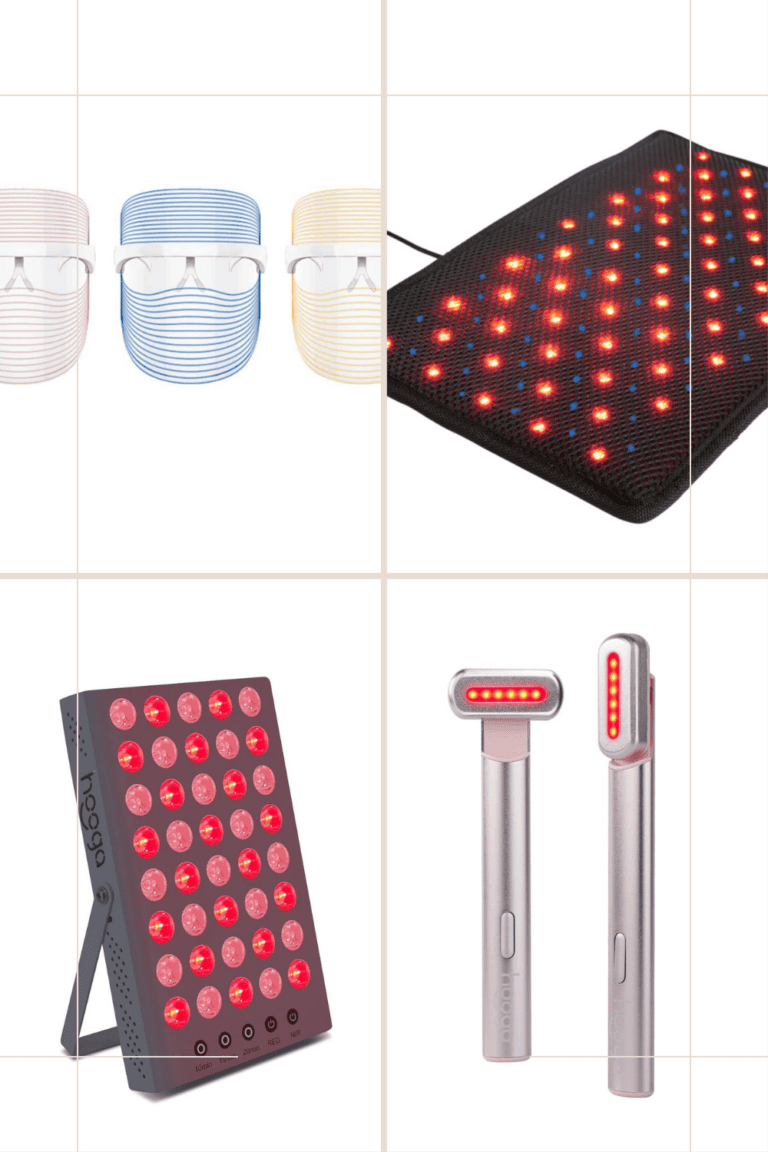Ceramic vs Stainless Steel Cookware: One Clear Winner
This post is about ceramic vs stainless steel cookware.
This post about ceramic vs stainless steel may contain affiliate links, which means I’ll receive a commission if you purchase through my link, at no extra cost to you.
Searching for the best AND safest cookware is really overwhelming and there’s a lot of confusing information out there. Today we are going to look at ceramic vs stainless steel cookware.
If you’re on the fence about which cookware to invest in for your culinary adventures, you’re in the right place. We’re about to slice and dice through the facts, compare the two side by side, and maybe, just maybe, crown one as the clear winner in this culinary showdown.
Ceramic Cookware in a Nutshell

Ceramic cookware refers to pots and pans that are either made from clay that has been kiln-baked and glazed with a ceramic coating or metal cookware that has been coated with a “ceramic” layer.
The term “ceramic” can apply to both types but is more commonly associated with the latter, which is metal cookware (such as aluminum) coated with a non-stick surface that has a ceramic look but actually this coating is typically made from silica, a component of sand, which is then cured onto the cookware’s surface at high temperatures.

Key Characteristics of Ceramic Cookware:
- Non-Stick Surface: Ceramic-coated cookware is prized for its non-stick properties, making it easier to cook with less oil and clean up afterward.
- Eco-Friendly-ish and Healthy-ish: The ceramic coating is generally considered safer and more environmentally friendly than traditional non-stick coatings, such as Teflon, because it doesn’t contain PTFE (Polytetrafluoroethylene) or PFOA (Perfluorooctanoic Acid), chemicals that have raised health concerns.
- Heat Distribution: High-quality ceramic cookware can provide excellent heat distribution, which helps in cooking food evenly. However, the performance can vary depending on the material of the cookware base.
- Temperature Tolerance: Ceramic cookware can withstand high temperatures – often up to 450°F or higher, making it suitable for a variety of cooking tasks. However, it’s essential to refer to the manufacturer’s guidelines as temperature tolerances can vary.
- Versatile Use: Many ceramic cookware pieces are designed to be used on the stovetop and in the oven, making them versatile kitchen tools.
- Aesthetic Appeal: Ceramic cookware often comes in a variety of colors and designs, adding a decorative touch to the kitchen.
The Downsides:
- Durability: While ceramic coatings offer excellent non-stick properties initially, they may wear down faster than traditional non-stick surfaces. Avoiding metal utensils and abrasive cleaners can help prolong the life of the cookware. Pure Ceramic cookware that doesn’t have a metal core could break when dropped more easily.
- Care and Maintenance: It’s important to follow the manufacturer’s care instructions to maintain the cookware’s performance and appearance. Gentle cleaning and avoiding rapid temperature changes can help prevent damage.
- Price: Ceramic cookware can vary in price based on quality, brand, and the type of cookware. Investing in high-quality pieces can provide better performance and longer lifespan.
- Lead & Heavy Metal Concern: This is where it becomes too confusing for my brain and I want to cry… There are a lot of mainstream ceramic brands that advertise that they don’t contain lead but then independent consumers have tested the products and they come back very high for lead so the truth is that these ceramic cookware pieces almost always DO contain lead BUT they don’t leach lead into food… So… the question is: if the lead doesn’t leach does it do any harm?
Ceramic cookware offers a healthier (than many other cookware options) option for those looking to avoid potentially harmful chemicals in non-stick coatings while enjoying the benefits of non-stick cooking and easy cleanup.
Popular Low Toxic Ceramic Cookware Brands
If I were to own a ceramic cookware piece, I would buy it from one of these brands only… and let me be clear- I probably never will.
Stainless Steel Cookware: The Timeless Warrior

In the realm of durability and versatility, stainless steel pans stand unmatched.
Known for their resilience, stainless steel pans offer a sleek, mirror-like finish that not only adds elegance to your kitchen but is also incredibly resistant to rust, corrosion, and stains.
Beyond aesthetics, these pans excel in high-heat cooking techniques, making them indispensable in professional kitchens and among home cooks seeking superior performance.
Why Stainless Steel Cookware Shines
Stainless steel cookware is the Hercules of kitchenware. Known for its durability and versatility, it’s a go-to for professional chefs and home cooks alike.
- Built to Last: Stainless steel is incredibly durable. A good set can last a lifetime, resisting rust, stains, and corrosion with proper care.
- Eco-Friendly: While there can be more of a detrimental eco-impact in the creation stage, stainless steel cookware can last a lifetime (or maybe half of one) and therefore doesn’t have to be replaced as often as other types of cookware.
- Safe: Stainless steel, cast iron, and glass cookware are considered the least toxic types of cookware. Because stainless steel cookware doesn’t have a coating you don’t have to worry about the coating chipping or scraping off into your food or exposing a less desirable metal underneath the coating (as with ceramic cookware).
- Versatility is Key: Whether you’re searing, sautéing, or simmering, stainless steel can handle it all. It’s compatible with all cooking surfaces and can go from stovetop to oven without a hitch.
Downsides To Stainless Steel
But, stainless steel isn’t perfect. Here are a couple of things to consider:
- Stickiness Situation: Unlike ceramic, stainless steel does not have a natural non-stick surface. This can lead to food sticking and sometimes a challenging cleanup. Later in this post I’ll share my trick to making stainless steel non-stick.
- Heat Conductivity: On its own, stainless steel doesn’t conduct heat as evenly as ceramic-coated cookware. However, many stainless steel pots and pans have aluminum or copper cores to help with this.
Popular Low Toxic Ceramic Cookware Brands
I currently own stainless steel pots and pans from Emeril that I received as a wedding gift 20 years ago. It was 20 years ago… before the time of iphones so although I know the purchaser (I think my grandmother) was trying to make the best and safest choice they could at the time, there’s not much info on them now.
Would I like to replace them with one of the brands below that has more testing, yes… but the Emeril pieces are sturdy and serving me well and it just isn’t in the budget. Howeverrrrrr, when it IS in the budget, I’ll be purchasing a new stainless steel cookware set from one of these companies with the highest standards and best testing:
What You Need to Consider When Choosing Between Ceramic vs. Stainless Steel Cookware
What Type Of Food Are You Cooking?
Choosing the right cookware is like selecting a dance partner for your culinary ballet—each step, or recipe, may require a different approach. In the tussle between ceramic and stainless steel cookware, adaptability becomes a key factor.
From whipping up a quick omelet to searing a gourmet steak, the material you choose influences your cooking style, outcomes, and convenience.
As we explore the versatility of ceramic and stainless steel in the kitchen, consider how each aligns with the dishes you love to prepare and the flexibility your cooking routine demands.
Ceramic Cookware: Gentle Cooking and Easy Cleaning
Ceramic cookware shines when it comes to non-stick cooking and easy cleanup. It’s the go-to for low to medium-heat cooking, where the risk of food sticking or burning is a concern. Its gentle heat is ideal for dishes requiring careful temperature control.
- Perfect for Delicate Dishes: Ceramic’s even heat distribution makes it suitable for recipes that call for consistent temperatures without the risk of hot spots.
- Ease of Maintenance: The non-stick surface not only allows for healthier cooking with less oil but also means washing up is typically a breeze, saving time and effort after meal prep.
- Ease of Cleaning: Nobody likes to clean the pan after eggs have gotten stuck to it. With non-stick ceramic-coated pans, cleaning is much easier.
Stainless Steel Cookware: The Versatile Powerhouse
In contrast, stainless steel cookware is celebrated for its robustness and versatility. Capable of handling high temperatures, it excels in a variety of cooking techniques, from searing meats to simmering hearty stews.
- High Heat Mastery: Stainless steel’s ability to withstand high temperatures makes it perfect for searing, browning, and even oven-roasting, offering a versatility that ceramic cookware can’t match.
- A Tool for Every Task: With a wide range of pots, pans, and specialty items, stainless steel cookware meets the needs of diverse cooking styles and preferences, ensuring there’s a tool for every culinary task.
Health and Safety Considerations in Cookware
Ceramic Cookware
The primary concern with ceramic cookware arises from the quality and durability of its coating.
Low-quality ceramic coatings can degrade over time, leading to chipping and flaking. While the material itself isn’t toxic, ingesting flakes of the coating is not advisable.
Furthermore, ceramic cookware can contain lead and cadmium in the glaze, particularly in poorly manufactured products, posing serious health risks. Tamara Rubin the “Lead-Free Mama” tested several “lead free” brands of ceramic cookware and found high levels of lead in them.
Stainless Steel Cookware
The main issue with stainless steel lies in the potential leaching of metals into food IF it is a low quality stainless steel alloy.
Tamra Rubin, who I mentioned above also tested several stainless steel cookware options and found all or most all of them to be lead and heavy-metal-free.
High-quality stainless steel cookware is generally safe, but cookware made with a high amount of nickel and chromium can pose risks, especially to those with nickel allergies.
Acidic foods (like tomato sauce) can exacerbate leaching, raising concerns about long-term exposure.
What is Stainless Steel Cookware Made Of?
Understanding what stainless steel cookware is made of is key to appreciating its value and functionality in the kitchen. Stainless steel is an alloy, a mixture of metals, that primarily consists of iron and chromium.
Chromium is added at a minimum of 10.5% to iron to produce stainless steel, granting the material its corrosion-resistant properties. The addition of chromium creates a thin layer of oxide on the surface of the steel, which helps prevent further corrosion, making it ideal for kitchen use.
Here’s a breakdown of the components found in stainless steel cookware:
- Iron: The base material that gives stainless steel its strength and durability.
- Chromium: A key element that provides corrosion resistance. A higher percentage of chromium enhances the steel’s ability to resist rust and staining.
- Nickel: Often added to stainless steel, nickel enhances corrosion resistance and gives the steel a more polished look. The presence of nickel also contributes to the steel’s non-reactive properties, making it safer for cooking acidic foods.
- Carbon: Though present in small amounts, carbon strengthens the alloy without compromising its flexibility.
- Molybdenum, Titanium, and Copper: Some stainless steel varieties may include these metals to enhance specific properties like heat conductivity and resistance to pitting, especially in environments with high salt exposure.
Types of Stainless Steel Cookware
Stainless steel cookware is often categorized by its grade, which refers to its composition and properties:
- 18/10 and 18/8 Stainless Steel: These numbers indicate the composition of chromium and nickel, respectively. For example, 18/10 stainless steel contains 18% chromium and 10% nickel, offering a good balance of durability, corrosion resistance, and allergen considerations.
- 304 Stainless Steel: Another designation for 18/10 stainless steel, known for its food-grade quality and resistance to oxidation and corrosion.
- 316 Stainless Steel: Also known as marine-grade stainless steel, it contains molybdenum, which provides enhanced corrosion resistance against chlorides like salt, making it an excellent choice for coastal environments.
- 18/0 Stainless Steel: For those with nickel allergies or concerns about nickel content in their cookware, nickel-free stainless steel offers an alternative. Nickel-free stainless steel cookware is made primarily from iron and chromium, without the addition of nickel. This type of stainless steel is often referred to as 18/0, indicating 18% chromium and 0% nickel.
When selecting stainless steel cookware, understanding its makeup helps in choosing the right type for your cooking needs and health considerations, particularly for those with nickel allergies or sensitivities.
What is Ceramic Cookware Made Of?
Ceramic cookware refers to two types: pure ceramic and ceramic-coated. Understanding the composition of each type can help you make an informed decision about which cookware suits your needs best.
Pure Ceramic Cookware
Pure ceramic cookware is made from clay and other natural minerals that are shaped, kiln-fired, and then glazed. This process produces a durable, non-metallic cooking surface that is known for its heat retention and uniform cooking capabilities. Pure ceramic is completely free from metals and synthetic coatings, making it an excellent choice for health-conscious cooks.
- Clay and Minerals: The primary materials that, when fired at high temperatures, solidify into a durable cooking surface.
- Natural Glaze: Applied for a smooth finish, the glaze on pure ceramic cookware also creates a non-stick surface without the use of chemical coatings.
Ceramic-Coated Cookware
Ceramic-coated cookware, on the other hand, starts with a metal base, typically aluminum, and is then coated with a layer of ceramic. The ceramic coating is derived from sand and applied as a hard, non-stick and non-toxic surface over the metal cookware.
- Aluminum Core: Provides excellent heat conductivity and is lightweight, making it a popular choice for the base material of cookware.
- Silicon Dioxide: The ceramic coating is primarily made from silicon dioxide, a natural compound found in sand. When cured at high temperatures, it forms a glossy, non-stick surface that’s free from PFOA and PTFE.
Considerations
While ceramic cookware offers many benefits, it’s essential to consider the quality and durability of the ceramic coating, as low-quality coatings may wear down over time.
Additionally, pure ceramic cookware is generally heavier and may require more careful handling to prevent chipping.
Unglazed ceramic cookware cookware may have heavy metals in the actual clay.
Glazed pure ceramic cookware may have heavy metals or toxins in the glaze.
Ceramic-coated cookware might have heavy metals or toxins in the coating AND if the coating chips off then aluminum is what you are actually cooking on.
To me, the big issue with all the ceramic options is that it is much more likely to scrape or chip off into your food than stainless steel over time and if that core or the glaze does contain lead, even if it normally wouldn’t leach into your food, you will then be ingesting it.
Transparency In Claims: Ceramic Cookware vs. Stainless Steel Cookware
What makes this whole ceramic vs. stainless steel debate so frustrating is that you can’t just take a brand’s claims at face value. It feels like you have to be a scientist with professional testing equipment to find out the truth.
It is scientifically shown that stainless steel cookware can leach nickle and chromium.
On the other hand, there are well known and trusted ceramic cookware brands that claim to be totally lead and heavy metal free when private testing shows otherwise.
Apparently, a product (ceramic cookware) can test lead-free during leaching tests but have high amounts of lead in the material.
This is so confusing to me… of course we don’t want to use cookware with high levels of lead… but also… if that lead isn’t transferring to food through leaching then does it even matter?
Gah!
What to Look for When Buying
Ceramic Cookware
- Quality: Opt for high-quality, reputable brands known for their durable ceramic coatings that don’t contain all the nasties.
- Certifications: Look for products certified to be free of lead, cadmium, PTFE, and PFOA.
- Warranty: A good warranty can be an indicator of the manufacturer’s confidence in their product’s durability.
If you do decide to use ceramic cookware, I suggest looking at these lowtoxic ceramic cookware brands:
Xtrema
- Ceramic through and through- no metal core.
- Encourages using abrasives like baking soda and scrubbers to clean which makes cleaning easier.
- Beautiful design.
- Does not leach lead but does contain lead according to XRF testing.
- Could break if dropped.
- Takes longer than metal to heat.
- Free of PTFE, PFAS, and other harmful chemicals.
- Safe to use on high heat (500+ degrees)
- Dishwasher safe
- Oven safe
- Stovetop safe
- Fridge and freezer-safe
- Won’t scratch or flake but could chip if dropped.
My take: I don’t like that it could break so easily if dropped because I feel like with my big family that might happen. Otherwise I like the specs and how you don’t have to baby it.
Our Place
- Totally nonstick
- Aluminum body (except for cast iron body products) with a “ceramic” coating. They don’t tell you what it actually is so my guess is it is silica based. I don’t like that they aren’t transparent.
- Beautiful
- Made to do it all good design and good sizes.
- Easy to clean but you have to use a soft sponge.
- NOT dishwasher safe
- There Always Pan is not oven-safe but their Perfect Pot is.:(
- You have to baby it a bit to protect the coating
- Free from PTFE, PFAS, and other harmful chemicals.
My take: I love the size options and that it works so great and is pretty. I don’t at all like that you have to baby the coating and that they aren’t transparent about what the coating is made of. I would prefer the cast iron options over aluminum. I WOULD use their Perfect Pot for bread baking if lined with parchment paper because this would remove the risks for scratching the coating.
Caraway
- Aluminum and stainless steel base covered with a non-toxic mineral “ceramic” coating- who knows what is actually in it. See my take below.
- Completely nonstick
- Easy to clean but NOT dishwasher safe.
- Amazing organization and thoughtful design.
- Super pretty.
- Can be chipped or scratched if you use metal utensils or scrub.
- PTFE, PFOA, lead, and cadmium, amongst other toxic chemicals
- Can go in the oven.
- Caraway also offers stainless steel cookware
My take: I like that this can go in the oven. I emailed Caraway to find out about the construction and this is what they said “Hi Ash, Thank you for reaching out and for your interest in our cookware products.Our pots and pans are made with an aluminum core and have a stainless steel base & handles. The interior is made with a non-stick ceramic coating free of lead, cadmium, PTFE (Teflon), PFOA, and other harmful chemicals.” So… the stainless steel is on the bottom of the pan- not under the non-toxic non-stick coating. Under the non stick coating is aluminum.
Green Pan
- Aluminum core with a sand-based proprietary “ceramic” coating that includes diamonds-named “Thermolon”
- Mentions being made of stainless steel and aluminum but there’s no clarity on what part is stainless steel.
- Free of PFAS, PFOA, LEAD & CADMIUM
- Handwashing is recommended but ok in dishwasher.
- Oven safe up to very high temps.
- Lots of style and color options.
My take: This company seems more transparent than the others. They include information the competitors don’t. I love that it can go in the oven and dishwasher but you still have to baby that coating. Not as cute in my opinion. Interested to get a reply from the company about what part of the pans are stainless steel.
Which Ceramic Cookware Option Would I Personally Buy?
This is a hard question. I think the Xtrema is probably the safest because the outer coating is less likely to scratch and chip off but I don’t think it’s as fun to cook with and it could break. If I had to choose from the metal base options I’d choose one of these options: 1. The Our Place Perfect Pot but only lined with parchment paper for bread baking or when I wouldn’t need to scrape it to clean it or cook. 2. Caraway. 3. Green Pan. I don’t see myself ever buying a set of any of these… maybe a Dutch oven and a frying pan but that’s it and I’d be careful and very thoughtful- it wouldn’t be my workhorse… just for dishes that I really want the non-stick power for (or bread baking).
Stainless Steel Cookware
- Material: Choose cookware labeled as “18/10” or “304,” indicating it contains 18% chromium and 10% nickel, offering a good balance of corrosion resistance and strength.
- Construction: Look for tri-ply or multi-ply construction, which typically has an aluminum or copper core enveloped by stainless steel layers for improved heat distribution.
- Finish: A brushed or matte finish can help hide wear and tear better than a mirror finish.
If you decide to use Stainless Steel Cookware, I suggest looking at these lowtoxic Stainless Steel cookware brands:
360 Cookware
- Consists of two outer layers of stainless steel (with the outermost layer having a lower nickel content) that encapsulate an inner aluminum layer that never touches food.
- PFAS, PFOS, PFOA and PTFE FREE
- Non-stick because of a sanding process they use- not because of a coating.
- Construction allows for their “vapor” cooking method that allows for less to no added oils and fats and ways to cook without adding water or liquid (as in, you can “boil” eggs without water… What???).
- Can be used in the oven up to 500 degrees Fahrenheit but not on broil or during pre-heating.
- Scrubbable and dishwasher safe.
- Lifetime Warranty!
- US-based & made and source as many parts as possible from the US.
- Take quality and integrity very seriously.
- Expensive
My take: I love everything about this brand but the price but sometimes that’s what the deal is when you want the best, the safest, and the most ethical option. For those with a smaller budget (like moi) this would be a great thing to ask for for Christmas and just replace your current cookware one piece at a time. Buy Here.
All Clad: D5 Brushed
- Lots of options but the best includes 3 layers of stainless steel with two layers of aluminum between them- like an alternating metal sandwich.
- Can be used with induction cooking.
- Oven and broiler safe
- Limited lifetime warranty
- Dishwasher not advised
- All Clad offers a lot of products-including non-stick and not safe options- I only suggest their D5 brushed stainless steel cookware- not the nonstick options though.
- Used by professionals- known to be excellent.
My take: Love that these are used by a lot of pros and have a good reputation but the fact that they aren’t as committed to nontoxic options and also that you aren’t supposed to put them in the dishwasher is a turn-off.
Heritage Steel
- Made in the USA
- 5 Ply fully clad: stainless steel and aluminum
- Lifetime warranty
- Can be used: on gas, electric, grill, induction, or oven!
- I couldn’t find any info on whether it was dishwasher safe but I did find videos where they suggest you clean with baking soda and scrape the pan so It sounds pretty durable.
- Nontoxic and free from PTFE
My take: I like that it’s a family owned US based business that takes a lot of pride and ownership in their product. I like that it can be used under almost any cooking condition. Buy Here.
Legends 5 Ply Stainless Steel
My take: The brand recognition isn’t as solid on this brand and I don’t think it’s the best of the best BUT it is more affordable.
Which Stainless Steel Cookware Option Would I Personally Buy?
I would be happy with all of these and feel safe with all of these but personally, I would choose 360 Cookware because of its unique features, dedication to nontoxic construction, its waterless vapor cooking feature, and the fact that it’s dishwasher safe. I also would consider other Legends sets because it is so much less expensive but still have good and safe specs, can be used on any surface and is dishwasher safe.
The Winner: Stainless Steel Cookware
While both types of cookware have their place in the kitchen, stainless steel cookware takes the crown for several compelling reasons:
- Durability: Stainless steel is tough. It resists warping, scratching, denting, and tarnishing. With proper care, it can last a lifetime.
- Versatility: It’s suitable for almost any cooking method, from searing to simmering.
- Safety: High-quality stainless steel cookware minimizes the risk of leaching, especially when used correctly.
- Ease of Maintenance: Though not non-stick, modern stainless steel cookware can be relatively easy to clean and is dishwasher safe.
- More Transparency: There is more research on stainless steel used in food applications and more transparency in testing and
How To Make Stainless Steel Non-Stick-ish
Since the big appeal of ceramic cookware is the non-stick component I thought I’d share with you how I make my stainless steel pan pretty darn non-stick!
- Heat the Pan: Place your stainless steel pan on the stove over medium heat. Let it warm up for a few minutes. It’s crucial not to overheat the pan; a moderate temperature is key.
- Water Droplet Test: Put a teaspoon of water in the pan and once water floats across the top of the pan it’s ready.
- Add Oil: Once the pan is properly preheated, add a thin layer of cooking oil with a high smoke point, such as avocado oil or refined coconut oil. Swirl the pan to evenly coat the bottom. The oil should shimmer but not smoke. If it starts to smoke, remove the pan from the heat briefly to cool down.
- Cook Your Food: Now, you can add your food to the pan. The preheated pan and oil create a barrier that prevents sticking, allowing food to be released more easily after cooking.
- Let the Food Release Naturally: When searing or frying, give the food time to form a crust before trying to flip or stir it. This natural crust will help the food release from the pan more easily.
Other Non-Toxic Cookware Options to Consider
While stainless steel (especially nickel-free) and ceramic cookware are popular choices for those seeking non-toxic options, several other materials are worth considering. Each has its unique benefits and can be a valuable addition to a health-conscious kitchen.
Cast Iron
Benefits:
- Natural Non-Stick Surface: When properly seasoned, cast iron offers a natural non-stick surface without the need for synthetic coatings.
- Durability: Cast iron is incredibly durable and can last for generations if cared for properly.
- Even Heating: Known for its excellent heat retention and even heating, cast iron is ideal for searing, frying, baking, and more.
- Iron Fortification: Cooking with cast iron can increase the iron content in your food, beneficial for those with iron deficiency.
Considerations:
- Maintenance: Cast iron requires regular seasoning to maintain its non-stick properties and prevent rust.
- Weight: It is significantly heavier than other types of cookware, which might be a consideration for some users.
Glass Cookware
Benefits:
- Chemical-Free: Glass is naturally non-toxic and doesn’t leach chemicals into your food, even at high temperatures.
- Easy to Clean: It is dishwasher safe and easy to clean, as it doesn’t absorb flavors or odors.
- Oven Safe: Most glass cookware can be used in the oven, making it versatile for various cooking methods.
Considerations:
- Heat Distribution: Glass doesn’t conduct heat as well as metal cookware and can be more prone to hot spots.
- Breakability: It can break if dropped or subjected to sudden temperature changes.
Carbon Steel
Benefits:
- Lightweight Alternative to Cast Iron: Carbon steel offers similar benefits to cast iron, including a natural non-stick surface when seasoned, but is lighter and easier to handle.
- High Heat Tolerance: Excellent for high-heat cooking techniques, such as stir-frying and searing.
- Durability: Like cast iron, carbon steel is very durable if properly maintained.
Considerations:
- Requires Seasoning: Needs to be seasoned to maintain non-stick properties and prevent rust.
- Reactivity: Like cast iron, carbon steel can react with acidic foods, which might affect the food’s flavor and color.
Each of these non-toxic cookware options offers unique benefits, and choosing the right one depends on your cooking preferences, budget, and health considerations. By selecting cookware made from safe, durable materials, you can enjoy delicious meals while minimizing exposure to harmful chemicals.
Enamel-Coated Cast Iron
Benefits:
- Non-Reactive Surface: The enamel coating provides a non-reactive surface, making it safe for cooking all types of foods, including acidic dishes.
- Low Maintenance: Unlike bare cast iron, enamel-coated cast iron doesn’t require seasoning and is easier to care for.
- Heat Retention: Retains heat well and provides even heat distribution.
Considerations:
- Price: Enamel-coated cast iron can be more expensive than bare cast iron.
- Durability of Coating: While the cast iron underneath is durable, the enamel coating can chip if mishandled. This is basically the same issue as with any of the ceramic options.
Conclusion
In the “ceramic vs. stainless steel” cookware debate, stainless steel emerges as the safer, more durable option.
It offers unparalleled longevity and performance in the kitchen, making it the ideal choice for chefs and home cooks alike.
When purchasing stainless steel cookware, prioritizing quality and construction ensures that you invest in pieces that are not only safe to use but will also stand the test of time.
I personally think the winning combo for a cookware set is:
- A set of high-quality stainless steel cookware
- A cast iron pan
- Glass Bakeware
- Stainless Steel Bakeware
- Perhaps a ceramic dutch oven for bread baking
I get that the ceramic cookware is pretty and some of it is eco-friendly and the non-stick option is amazing, BUT I personally don’t own anything in this class and am perfectly happy using only stainless steel, cast iron, and glass cookware. Unless someone gifts you a low-toxic ceramic cookware set OR you can not figure out how to make something you frequently make work with stainless steel, cast iron, or glass, I personally don’t think it’s worth introducing even any possible risks that ceramic cookware might carry, especially when it’s also not as durable.
For me, the exception might be a dutch oven to cook my sourdough bread in since I line that with a piece of parchment paper and am never scraping or scrubbing it. What are your thoughts?
This post was about ceramic vs stainless steel
Last update on 2024-07-23 / Affiliate links / Images from Amazon Product Advertising API
This product presentation was made with AAWP plugin.

